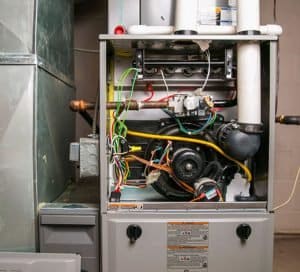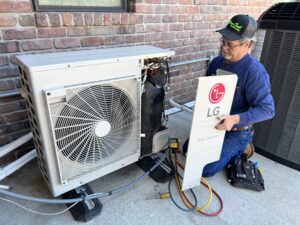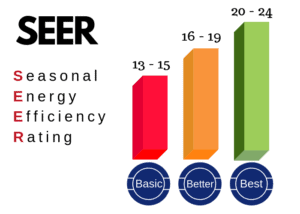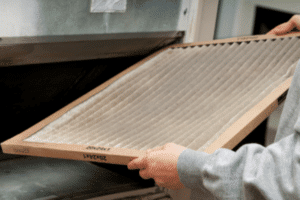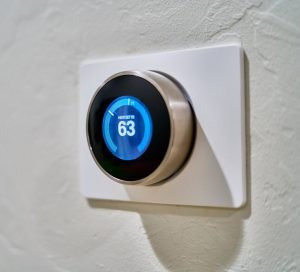Indoor air quality has always been important, but improving indoor air quality has also recently become a “hot-topic” due to COVID-19. An abundance of scientific research shows that the air within homes and businesses can be more polluted than that which you would find within a large industrialized city. Indoor air quality becomes even more important when you consider the fact that the majority of people spend all day indoors. In fact, the Environmental Protection Agency (EPA) states that indoor air pollutants may be up to 100 times higher than levels of outdoor pollutants and are ranked among the top 5 environmental threats to human health.
You may be wondering what causes poor indoor air quality. Often, poor indoor air quality results from inadequate ventilation, pollutant sources found within the home (for example, building materials, paint, varnishes, sealants, off-gassing from furniture, carpets, wood products, household cleaning products, personal care products, and fragrance), as well as pollutant sources found outside the home (for example, pesticides, radon, and outdoor air pollution). If your home is not well ventilated then these pollutants can accumulate to unhealthy levels.
Research shows that irritation to the eyes, nose, and throat, as well as headaches, fatigue, and dizziness are often linked to poor air quality. Additionally, it’s important to realize that the negative health effects from poor indoor air quality may not show up until years after the exposure.
You may be wondering what steps you can take as a homeowner or business owner to improve the indoor air quality. Today we will be covering 4 easy ways to improve your indoor air quality.
Focus on Improving Ventilation
The first and likely the easiest change that you can make to improve your indoor air quality is by increasing the ventilation in your home. Simply opening your windows and doors when the weather permits can significantly help your indoor air quality. Also, often bathroom and kitchen exhaust fans help remove contaminants directly from the room where the fan is located and can help increase the outdoor air ventilation rate.
Consider also that activities such as painting, cooking, welding, and sanding can generate significant pollutants. If possible, complete these activities outdoors or open the windows and doors in your home while engaging in these activities.
 Change your Air Filters Regularly
Change your Air Filters Regularly
Secondly, making sure your HVAC air filters are refreshed regularly will help with your indoor air quality. Over time, your HVAC system’s air filters will become clogged with dust, dirt, and other particles found in the air. We recommend checking your air filter on a monthly basis. In addition to helping keep your air clean, replacing your air filter will also provide the added benefit of energy efficiency. Meaning, replacing a dirty air filter with a clean air filter will result in your HVAC system being able to work more easily and more efficiently. Also, keep in mind that if animals live in your home, your air filters will need to be changed more frequently.
 Freshen your Air with House Plants
Freshen your Air with House Plants
Having indoor plants can help scrub your air clean! Some scientists say that houseplants are effective natural air purifiers.
According to scientist Bill Wolverton, the bigger the plant leaf, the better. Mr. Wolverton stated that the “amount of leaf surface area influences the rate of purification.” This scientist recommends individuals have two plants per 100 square feet of indoor space.
If cleaning your air isn’t enough incentive to add some pretty houseplants to your home, the research also shows that plants can help with stress reduction because spending time around nature has a overall positive effect on an individual’s energy and mood. Country Living published the 10 best air purifying plants for the home as the following: Barberton Daisy, English Ivy, Snake Plant (also called Mother-In-Law’s Tongue), Chrysanthemum, Spider Plant, Aloe Vera, Broad Lady Palm, Red-Edged Dracaena, Weeping Fig, and Chinese Evergreen.
Have a Whole Home Air Purifier Installed
Many individuals are adding air purifiers to their heating and cooling systems to encourage healthy air in their home. While there are many air cleaners on the market, we recommend an in-duct whole home air purifier. A properly selected air purification system for your home will continuously clean and protect the air (and surfaces) 24 hours a day.
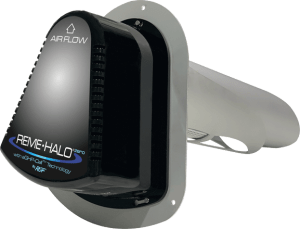
Two of the most popular air purification systems are the Reme Halo (“Halo”) and the Air Scrubber by Aerus (“Air Scrubber”). These air purifiers are designed to eliminate particulates, air pollutants, chemical odors (also called VOCs), smoke, mold bacteria, and viruses. Notably, Kansas State University conducted a study with the Halo that showed the Halo kills 99% of the germs from a sneeze within three feet, as well as 99% of viruses found on hard surfaces. The Air Scrubber and Halo are the caliber of air purifiers that hospitals, schools, and NASA are using.
You’d likely be surprised to know just how affordable these air purification systems are for the average homeowner and business owner. At Larry Cook Heating and Cooling, we offer free estimates. We would be happy to come to your home or business to provide our best recommendation to improve the indoor air quality of your space. Contact us today by calling 316-322-5668!
New Trends and Technologies in Indoor Air Quality Improvement
As technology continues to advance, several innovative solutions are emerging to help homeowners improve indoor air quality more effectively. Here are some of the latest trends and technologies in the field:
1. Smart Air Quality Monitors
Smart air quality monitors are becoming increasingly popular, allowing homeowners to track the levels of pollutants like CO2, VOCs (volatile organic compounds), and particulate matter in real time. These devices can be integrated with smart home systems and connected to mobile apps, providing instant alerts and suggestions for improving air quality. Popular models, such as the Awair Element and Airthings Wave, offer insights into temperature, humidity, and pollutant levels, helping homeowners take proactive steps to maintain healthy indoor environments.
2. UV-C Light Air Purifiers
UV-C light technology is a growing trend in air purification. UV-C light air purifiers work by using ultraviolet light to kill or inactivate airborne pathogens such as bacteria, viruses, and mold spores. This technology is now being integrated into HVAC systems to provide continuous disinfection of circulating air. The Reme Halo and Air Scrubber by Aerus are two examples of air purifiers that utilize UV-C light to improve indoor air quality by neutralizing harmful microorganisms.
3. HEPA Air Purifiers with Carbon Filters
HEPA air purifiers have long been a staple in improving indoor air quality, but new models now come equipped with activated carbon filters to remove odors, gases, and VOCs in addition to particulates. These dual-function purifiers are ideal for those looking to address both particulate and gaseous pollutants, offering comprehensive air cleaning. Models such as the Dyson Pure Cool and Blueair Classic are leading the way in combining HEPA and carbon filtration for enhanced air quality.
4. Energy Recovery Ventilators (ERVs) and Heat Recovery Ventilators (HRVs)
Modern homes are being built with ERVs and HRVs that ensure proper ventilation without wasting energy. These systems exchange stale indoor air with fresh outdoor air while retaining the temperature and humidity levels inside the home. This means homeowners can enjoy the benefits of fresh air without the high energy costs typically associated with ventilation. ERVs are particularly useful in humid climates, while HRVs work well in colder regions, making them adaptable to different environments.
5. Indoor Air Quality as a Smart Home Feature
Smart home ecosystems are now incorporating air quality management as a central feature. Devices like smart thermostats can control HVAC systems based on real-time air quality data, adjusting ventilation, filtration, and humidity control automatically. This integration ensures optimal air quality while maintaining energy efficiency. Systems like the Nest Learning Thermostat or Ecobee SmartThermostat can be paired with air quality monitors and purifiers to create an interconnected system that enhances home comfort and health.
By adopting these cutting-edge technologies, homeowners can significantly improve the air quality in their homes, making it easier to maintain a healthy living environment while benefiting from energy efficiency and convenience.
Shocking Truth About Wichita’s Air Quality
In Kansas, local air quality concerns can be influenced by seasonal factors such as agricultural activities, dust storms, and pollen. During the spring and summer months, pollen counts from crops and grasses can spike, leading to increased allergy symptoms for many residents. Additionally, dust from farming and wind erosion can reduce outdoor air quality, particularly in rural areas. Kansas also experiences wildfires and controlled agricultural burns that can contribute to elevated levels of particulate matter in the air.
For homeowners in Kansas, it’s essential to mitigate these outdoor pollutants by using air purifiers with HEPA filters and ensuring proper ventilation inside the home. Regular maintenance of HVAC systems and the use of high-efficiency filters can significantly improve indoor air quality, protecting against the outdoor elements common in the region.
For more tips, tricks, and advice click HERE to view our YouTube Channel!
Frequently Asked Questions (FAQs) on Improving Indoor Air Quality
How can I improve air quality in my small apartment?
- Answer: Improving air quality in a small apartment starts with increasing ventilation. Open windows when possible or use exhaust fans in kitchens and bathrooms. If outdoor air quality is poor, consider using an air purifier with a HEPA filter that is suitable for small spaces. Regularly clean surfaces to remove dust, and avoid using chemical-laden cleaners.
What are the best air purifiers for allergies?
- Answer: The best air purifiers for allergies are those with a True HEPA filter, which can capture 99.97% of allergens like pollen, pet dander, and dust mites. Look for purifiers with additional carbon filters to remove odors. Popular models include the Reme Halo and IQAir HealthPro series.
How often should I change my HVAC air filters?
- Answer: HVAC air filters should typically be changed every 30-90 days depending on usage. Homes with pets or in areas with high pollution may require more frequent changes, such as every 30 days. Regularly check filters to ensure they are not clogged with dust or debris.
How do I reduce dust and allergens in my home?
- Answer: To reduce dust and allergens, use high-quality HVAC filters, vacuum regularly with a HEPA vacuum cleaner, and dust surfaces with microfiber cloths. Wash bedding frequently, and remove or clean carpets, which can trap allergens. Adding indoor plants like English Ivy or Spider Plants can also help.
Does indoor air quality affect sleep?
- Answer: Yes, poor indoor air quality can disrupt sleep by causing irritation to the respiratory system, triggering allergies, and increasing CO2 levels in poorly ventilated rooms. To improve air quality for better sleep, use a portable air purifier in the bedroom and ensure the room is well-ventilated.
Can indoor plants improve air quality?
- Answer: While some studies suggest that indoor plants can remove small amounts of pollutants, their effectiveness is limited in home settings. However, they can contribute to stress reduction and add natural beauty to your space. Plants like Snake Plant, Aloe Vera, and Peace Lily are often recommended for air purification.
What are the common indoor air pollutants?
- Answer: Common indoor air pollutants include dust, pollen, pet dander, volatile organic compounds (VOCs) from paints and cleaning products, mold spores, radon, and carbon monoxide. Reducing these pollutants involves proper ventilation, regular cleaning, and using air purifiers.
How can I improve the quality of air in my home during winter?
- Answer: Improving air quality during winter can be challenging due to closed windows. Use an HVAC system with a fresh air intake or a heat recovery ventilator (HRV) to bring in fresh air without losing heat. Regularly replace filters and avoid using fireplaces or wood stoves, which can release particulate matter into the air.
What is the optimal humidity level for indoor air quality?
- Answer: The optimal humidity level for indoor air quality is between 30-50%. Maintaining this level helps prevent the growth of mold and dust mites, which thrive in high humidity. Use a humidifier or dehumidifier to control indoor humidity based on your local climate.
Can poor indoor air quality cause health problems?
- Answer: Yes, long-term exposure to poor indoor air quality can lead to health issues such as allergies, asthma, headaches, fatigue, and respiratory infections. In severe cases, exposure to pollutants like radon or VOCs can increase the risk of lung cancer or chronic respiratory conditions.
Content updated on September 4th, 2024 to reflect new technologies related to improving your indoor air quality.
Sources:
[3] https://time.com/5105027/indoor-plants-air-quality/
[4] https://www.rgf.com/products/air/reme-halo/
[5] https://www.airscrubberbyaerus.com/[/vc_column_text][/vc_column][/vc_row]

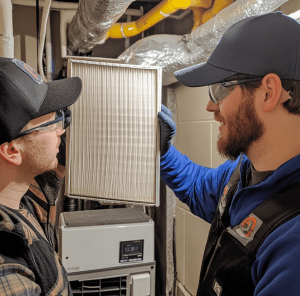 Change your Air Filters Regularly
Change your Air Filters Regularly  Freshen your Air with House Plants
Freshen your Air with House Plants
